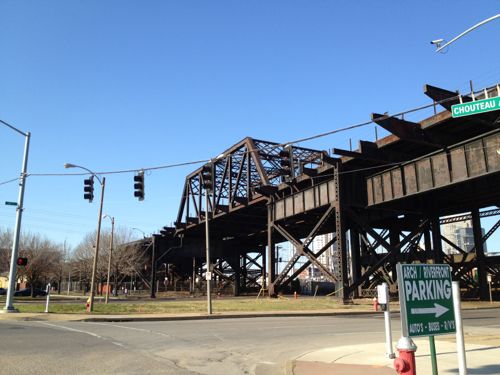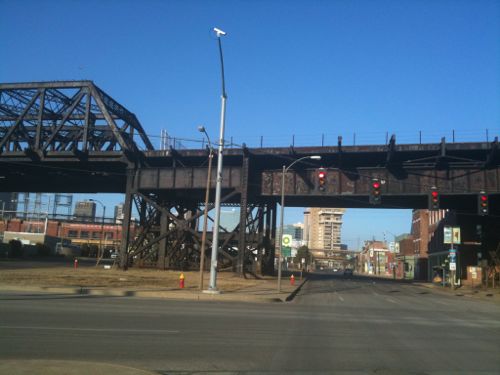Approaching the MacArthur Bridge (Updated)
One of the differences I see between urbanists and suburbanites is the love of old vs new, respectively. Urbanists see beauty in old, even decaying, structures whereas others feel more comfortable around new everything. Take the Missouri approach to the MacArthur Bridge over the Mississippi River as an example.

I love the rusting steel structure.
The MacArthur Bridge over the Mississippi River between St. Louis, Missouri and East St. Louis, Illinois is a 647 foot (197 m) long truss bridge. Construction on the bridge was begun in 1909 by the city of St. Louis to break the Terminal Railroad Association of St. Louis’s monopoly on the area’s railroad traffic. Money ran out before the bridge approaches could be finished, however, and the bridge did not open until 1917, and then only to automobile traffic. Railroad traffic would not use the bridge’s lower deck until 1928. The bridge was initially called the “St. Louis Municipal Bridge” and known popularly as the “Free Bridge.” Tolls were added for auto traffic beginning in 1932. In 1942 the bridge was renamed for Douglas MacArthur. The MacArthur Bridge was one of several bridges in St. Louis which carried U.S. Highway 66 until the completion of the nearby Poplar Street Bridge. At one time U.S. Highway 460 crossed the bridge, terminating on the west side of the bridge. In 1981 the bridge was closed to vehicles because of pavement deterioration and the western ramp approaches were torn out. The bridge is now in use only by railroads. Â (Wikipedia)
Sure I love the bridge itself but the approach is…well, approachable. I’m sure most suburbanites don’t see the beauty I see. To them it is an eyesore that should be removed or replaced.

I’ve crossed this bridge once on Amtrak but I prefer seeing the structure from the area around 4th Street & Chouteau. When I’m driving in the area I hope for red lights just to be able to look at the structure longer. When I’m on the bus I get to look at it without worrying about being distracted.
Do you see what I see? Or do you just see rusted steel?
UPDATE:
I need to clarify my suburbanite vs urbanite thesis. Many urban dwellers have rejected New Urbanism because of it’s newness even though it is otherwise well designed and compact. Similarly “newness” is always included a criteria in suburban preference studies. One study in California looking at residents of traditional neighborhoods & suburban neighborhoods found: “Residents in suburban neighborhoods have a higher average score for the safety factor, and among the individual attributes, their average ratings are particularly higher for cul-de-sacs, newness, school quality, parking, and quiet.“ (emphasis added). I’ll dig into all the  large amount of literature and do a followup post.
 – Steve Patterson
Not only an iconic structure, I think this bridge is a huge opportunity to create a signature “gateway” to downtown. If they lit up the trestle at night, it could become a destination in itself, and really help the Choutea’s Landing area keep growing.
Especially at Christmastime, would be awesome to have a lights display here
Not only an iconic structure, I think this bridge is a huge opportunity to create a signature “gateway” to downtown. If they lit up the trestle at night, it could become a destination in itself, and really help the Choutea’s Landing area keep growing.
Especially at Christmastime, would be awesome to have a lights display here
Louisville has a similar structure, the Big Four Bridge over the Ohio River, that has had the approaches removed from both sides, yet they continue to outline the bridge arches in lights and plans continue to add pedestrian access.
As to your closing question, I like both (old and new). Traditional materials and the patina that only time can generate have their place, just like how new materials and new proportions have their places. I also don’t think that it’s an either-or issue, it’s a question of degree. It’s also a question of terminology  You seem to want to equate urbanists with preservationists, while equating suburbanites with non-preservationists. I would assert that preservation and urbanism are distinct issues / agendas. To me, urban equals dense, and not necessarily old. There are some great new dense mixed-use urban projects being built around the country (but not here), just like there are some interesting and important historic properties that are neither urban nor dense.
Louisville has a similar structure, the Big Four Bridge over the Ohio River, that has had the approaches removed from both sides, yet they continue to outline the bridge arches in lights and plans continue to add pedestrian access.
As to your closing question, I like both (old and new). Traditional materials and the patina that only time can generate have their place, just like how new materials and new proportions have their places. I also don’t think that it’s an either-or issue, it’s a question of degree. It’s also a question of terminology You seem to want to equate urbanists with preservationists, while equating suburbanites with non-preservationists. I would assert that preservation and urbanism are distinct issues / agendas. To me, urban equals dense, and not necessarily old. There are some great new dense mixed-use urban projects being built around the country (but not here), just like there are some interesting and important historic properties that are neither urban nor dense.
Urbanists and preservations have overlapping interests. Much of what preservationists want to preserve is good old urbanism. We may be on opposite sides if an old parking garage is slated for demolition.
Urbanists and preservations have overlapping interests. Much of what preservationists want to preserve is good old urbanism. We may be on opposite sides if an old parking garage is slated for demolition.
Steve,
Unfair characterization of suburbanites. My wife (a teacher) and myself (an architect) are suburbanites with commutes under 10 minutes (25 by bike) because we live close to where we work.
Oh, and we love old things. It’s not a matter of old vs. new but more about good design vs. bad design (and there is plenty of bad design in burbs). Truth in materials and form are what make the bridge a unique and valuable landmark structure (one man’s rust is another man’s patina). The idea of lighting it up at night is great, thoughtful lighting can make even the most banal structures look grand.
Just thought I’d rib you a bit there, I get hassled by my “city” friends all the time for living in the burbs, even though I can use my car less than most of them.
Love the blog, keep it up.
Steve,
Unfair characterization of suburbanites. My wife (a teacher) and myself (an architect) are suburbanites with commutes under 10 minutes (25 by bike) because we live close to where we work.
Oh, and we love old things. It’s not a matter of old vs. new but more about good design vs. bad design (and there is plenty of bad design in burbs). Truth in materials and form are what make the bridge a unique and valuable landmark structure (one man’s rust is another man’s patina). The idea of lighting it up at night is great, thoughtful lighting can make even the most banal structures look grand.
Just thought I’d rib you a bit there, I get hassled by my “city” friends all the time for living in the burbs, even though I can use my car less than most of them.
Love the blog, keep it up.
I don’t think it’s an unfair characterization at all. In general suburbanites equate newness with order and older areas with chaos.
I don’t think it’s an unfair characterization at all. In general suburbanites equate newness with order and older areas with chaos.
Nope, it is a sweeping generalization.
Nope, it is a sweeping generalization.
Based on your post, I know you enjoy looking at the bridge. Other than the rust, though, what exactly is it about the bridge that excites you? Can you explain?
Based on your post, I know you enjoy looking at the bridge. Other than the rust, though, what exactly is it about the bridge that excites you? Can you explain?
I can’t fully explain it, the proportions are pleasing to me. The industrial history that led to the construction adds to the appeal. When a train is crossing I’m frozen unable to move as I watch it make it’s way.
I can’t fully explain it, the proportions are pleasing to me. The industrial history that led to the construction adds to the appeal. When a train is crossing I’m frozen unable to move as I watch it make it’s way.
I like the structure itself, but I can’t stand the surrounding fast food restaurants, gas stations, empty storefronts, the unkept empty lots and trash blowing through the streets and nearby properties.Â
I like the structure itself, but I can’t stand the surrounding fast food restaurants, gas stations, empty storefronts, the unkept empty lots and trash blowing through the streets and nearby properties.
I had (and still have) big hopes for the MacArthur Bridge and Chouteau’s Landing. By my personal opinion, when Chouteau’s Landing is rehabbed and revitalized — be that for industrial, nightlife, residential or mixed — it will signal the return of St. Louis as a great city.
SOM Hargreaves (et al.) had a really beautiful vision for the bridge which preserved its look, respected its utility (both or freight and passenger rail) and activated it as a kind of High Line-esque path to the east. MVVA, in short, has nothing planned for the south side. I would die a happy man to see a vibrant central city where this bridge (as well as the McKinley) is used to carry local heavy rail commuter trains (similar to Chicago’s Metra) into Union Station from surrounding Illinois communities.
By the way, awhile back I wrote about my return to St. Louis via the MacArthur Bridge over on YASTLBlog. The city looks so different when you arrive into it via train:Â
http://yastlblog.blogspot.com/2010/05/sweet-home-st-louis-returning-travelers_09.html
I had (and still have) big hopes for the MacArthur Bridge and Chouteau’s Landing. By my personal opinion, when Chouteau’s Landing is rehabbed and revitalized — be that for industrial, nightlife, residential or mixed — it will signal the return of St. Louis as a great city.
SOM Hargreaves (et al.) had a really beautiful vision for the bridge which preserved its look, respected its utility (both or freight and passenger rail) and activated it as a kind of High Line-esque path to the east. MVVA, in short, has nothing planned for the south side. I would die a happy man to see a vibrant central city where this bridge (as well as the McKinley) is used to carry local heavy rail commuter trains (similar to Chicago’s Metra) into Union Station from surrounding Illinois communities.
By the way, awhile back I wrote about my return to St. Louis via the MacArthur Bridge over on YASTLBlog. The city looks so different when you arrive into it via train:
http://yastlblog.blogspot.com/2010/05/sweet-home-st-louis-returning-travelers_09.html